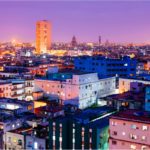Cuba is a fascinating country that has been dominated by its recent history in the world, both on its home shores and in the international community.
It is a country that has been at the center of international news for over 60 years and has been caught between the ambitions and rivalries between other nations, whilst also being forced to contend with its domestic issues, both for itself, and the rest of Latin America.
It can often be very difficult to understand why and how Cuba has found itself in the position it is in today.

Not only that, but it can often feel like the modern regime that currently governs Cuba is its entity, with little to no regard for the systems of government that came before it, and in many cases, directly contributed to its current state.
In the same way that the United States traces the origins of its institutions back to its government back to the Declaration of Independence in 1776, over 200 years ago, Cuba’s history tells us as much about how the current government came into existence as it does about how much it has changed over the years.
In this article, we will explain the history of Cuba’s many governments throughout the last several hundred years, as well as how each one has often led to the reasons for its successor to come to power.
There’s a lot to cover, so let’s get started!
Cuban Government Before And After Spanish Conquest
The history of people living in Cuba goes back to long before Columbus first found his way to its shores.
Evidence has been found of people living on the island since at least the 4th millennium BC.
Governance and rule-making would likely have been at a very local level, with the various indigenous populations of the Caribbeans, Mainland America, such as the Ciboney, Arawak, and Taino people, as well as Cuba’s people, the Guanajatabey, living across the islands of the Caribbean.
With relatively fertile waters and lands, as well as several crops that could be grown there, such as maize, cotton, sweet potatoes, and yucca roots, cultivating crops and food in Cuba, as well as living off of a hunter-gatherer lifestyle, provided many resources for growing and providing for themselves.
It was that ability to grow a wide number of crops that would eventually bring the focus of the Spanish Empire as it began to colonize and conquer the New World.
After Columbus’s second voyage.
With both a mandate from Pope Alexander VI and looking to set up new permanent settlements in the Caribbeans, the Spanish would begin colonizing the island.
Through a combination of brutal conquest and disease, much of the native populations that had made their home in Cuba would be forced to the margins.
Spanish governance of the island at this time would be dictated by the ‘encomienda’ system that forced non-Christians and other natives into servitude under the Catholic Spanish government.
This also included the moving of enslaved people, both from around the Caribbeans and Africa, to work as slaves for the picking of many crops grown on the island.
Reform & Independence

By the turn of the 19th century, Cuba was in the process of expanding its economy, thanks to the lifting of economic regulations that had monopolized the trade of sugar in the Caribbeans.
At the same time, many independence movements, such as the 1776 Declaration of Independence in the United States, as well as the successful slave revolt and independence of Haiti in 1789, alongside the Iberian Peninsular War In Europe in 1807, spearheaded a movement for Cuba’s independence from Spain as its nation, that helped cultivate ideas of Cuban nationalism separate from Spanish governance.
Along with this, a new movement prompted a response from Spain, with several reforms that were brought in by the new Spanish constitution, after Ferdinand VII had been deposed, that hoped to quell these ideas of independence and rebellion with more modern reforms.
Still, this did not stop these ideas from being spread among Cuba’s high society.
This was especially the case once Ferdinand VII, who had returned to the Spanish throne in 1823, dissolved the constitution and returned Spain and its colonies to an Absolute Monarchy, with Cuba officially under Spanish parliamentary rule, and with no representation.
This spared further calls for independence from many vocal Cubans, as well as some calls for annexation by the United States during the 19th century.
This was especially the case amongst many Cuban land and slave owners, who were concerned that a push for independence may bring with it slave reform and abolition, something that was still a ways off in the US.
Corruption & Revolution
Spanish rule of Cuba would end after the Spanish-American war in 1898, after which the US would annex the island for almost 3 years, whilst allowing for US trade and corporate interests to operate in Cuba.
Cuba would officially become independent in 1902, although the country had issues with widespread discrimination, continued intervention and occupation from the US on multiple occasions, as well as the suppression of political parties, including the Partido Independiente do Color, made primarily of Afro-Cubans that were former slaves.
Widespread corruption was also an issue for the young country, which would lead to continued unrest throughout the 1920s and 30s.
The Sergeant’s Revolt, a coup d’etat that took place in 1933, saw the leader of the revolt, Fulgencio Batista, rise to prominence as the leader of Cuba, a position he would hold from 1933 to 1944, before being part of another coup in 1952.
This second dictatorship would eventually lead to the rise of revolutionary groups, including the 26th July Movement that was in part led by Fidel Castro, who would eventually depose Batista in 1959.
Final Thoughts – The Modern Day
As we can see, modern Cuba today is not just directly influenced by the dictatorship that came immediately before it, but the long history of colonization that informed that government as well.
- What Is The Largest Island In Cuba? - September 19, 2022
- Havana – Why Is It Cuba’s Most Exciting City? - September 19, 2022
- Cheapest Time To Visit Cuba (Ultimate Guide) - September 19, 2022








